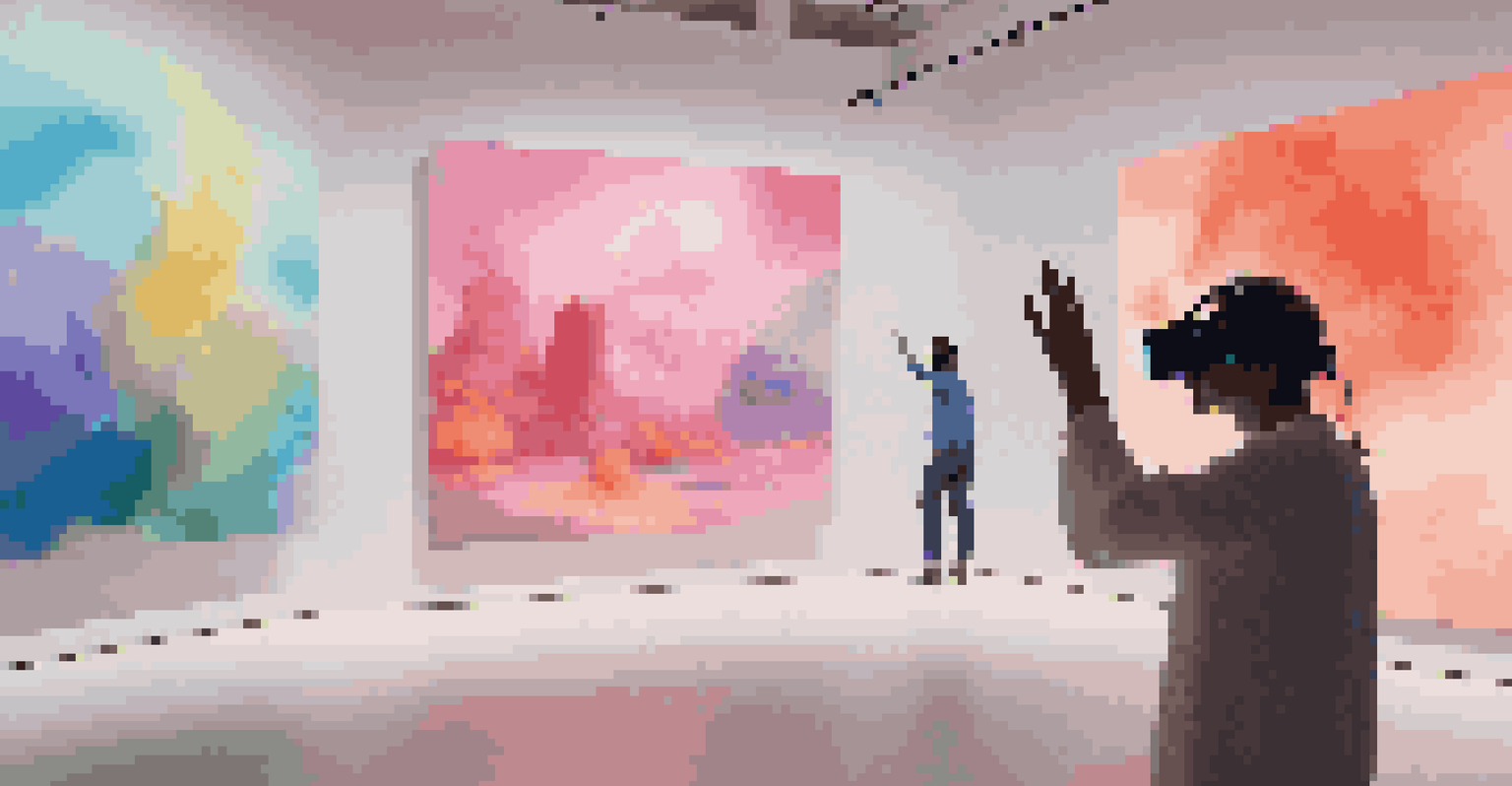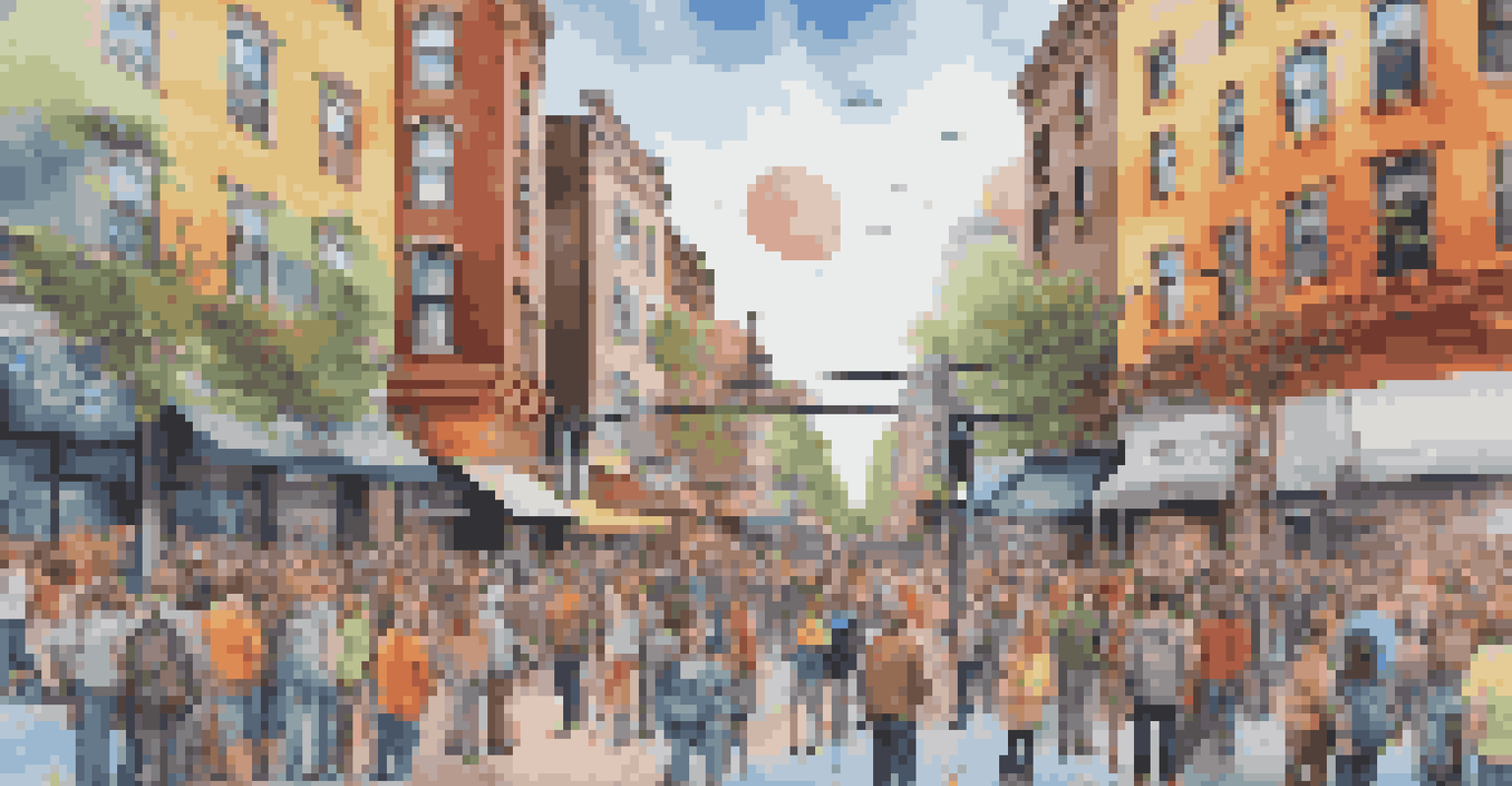The Intersection of Art and Technology: New Media Innovations

Understanding New Media: What Is It Really?
New media refers to digital forms of communication and art that have emerged with technology. Unlike traditional media, which is static and often one-way, new media allows for interactivity and dynamism. Think of it as the evolution of art that incorporates digital tools, making it more accessible and engaging for audiences.
Art is not a mirror held up to reality, but a hammer with which to shape it.
Examples of new media include video art, digital installations, and interactive websites. This shift opens up a dialogue between the artist and the viewer, as the audience can now play an active role in the experience. It’s like turning a painting into a live performance where everyone can influence the outcome.
As technology continues to advance, new media evolves, creating fresh opportunities for expression and storytelling. Artists today are not just creators but also innovators, merging their creative visions with cutting-edge tools. This intersection of art and technology is reshaping how we perceive and engage with art.
The Role of Virtual Reality in Artistic Expression
Virtual reality (VR) is transforming the way artists create and audiences experience art. By immersing viewers in a 3D environment, VR allows for a completely new dimension of interaction. Imagine walking through a digital gallery where you can touch and manipulate the artwork around you, creating a personal connection with the pieces.

Artists like Marina Abramović have begun to explore VR to enhance their performances, bringing audiences into their world in ways that were previously unimaginable. This technology not only broadens the scope of artistic expression but also invites viewers to participate actively in the narrative. It's akin to stepping into a storybook where you control the plot.
New Media Enhances Artistic Interaction
New media transforms traditional art forms into interactive experiences, fostering deeper engagement between artists and audiences.
As VR technology becomes more accessible, we can expect to see even more innovative uses in the art world. It pushes the boundaries of creativity, encouraging artists to think outside the traditional canvas and engage audiences on a deeper level. This evolution marks a significant milestone in the relationship between art and technology.
Augmented Reality: Blending Real and Digital Worlds
Augmented reality (AR) overlays digital content onto the real world, creating a unique blend of the physical and virtual. This technology has opened new avenues for artists to enhance their work with interactive layers that engage viewers in real-time. Picture scanning a mural with your phone and watching it come to life with animations and sound.
The technology is not the art; it is the tool that allows the artist to express their vision.
Artists like Kelsey Montague have utilized AR to create interactive street murals that encourage public participation. These projects not only beautify urban spaces but also foster community interaction and creativity. It’s like a treasure hunt where every corner holds a new surprise, inviting exploration.
As AR technology continues to evolve, its applications in art are only limited by the imagination. Artists can create experiences that challenge our perceptions of reality, inviting us to see the world through a different lens. This innovative fusion of art and technology makes art more accessible and engaging than ever before.
The Impact of Artificial Intelligence on Art Creation
Artificial intelligence (AI) is making waves in the art world, offering tools that assist artists in their creative processes. From generating unique imagery to suggesting color palettes, AI acts as a collaborator rather than a competitor. Imagine having a creative partner that provides endless inspiration at the click of a button.
Artists like Refik Anadol are using AI to create mesmerizing installations that respond to data in real-time. This technology allows for the creation of artworks that evolve and change, reflecting the world around us. It’s similar to having an artist that never sleeps, continually adding layers to their work.
Tech Innovations Shape Art's Future
Emerging technologies like VR, AR, and AI are redefining artistic expression, enabling creators to explore new dimensions and connect with viewers.
While some may worry that AI could replace human creativity, it is more of a tool to enhance artistic expression. By automating certain tasks, artists can focus more on the conceptual aspects of their work. This partnership between human creativity and machine intelligence is paving the way for the future of art.
Digital Platforms: Expanding the Reach of Art
The rise of digital platforms has transformed how art is shared and experienced. Websites and social media enable artists to reach global audiences, breaking down geographical barriers. It’s as if the whole world has become a gallery, where anyone can explore and appreciate art from the comfort of their home.
Platforms like Instagram and TikTok have not only popularized visual art but also fostered new forms of artistic expression, such as video art and digital storytelling. Artists can share their process, engage with fans, and even sell their work directly. It’s a refreshing change from traditional gallery exhibitions, making art more accessible to everyone.
As the digital landscape continues to evolve, artists will find new ways to connect and collaborate. This shift empowers creators to showcase their work on their own terms and build communities around their art. It’s an exciting time for both artists and art lovers alike.
Interactive Installations: Engaging Audiences Physically and Emotionally
Interactive installations invite viewers to become part of the artwork, blurring the lines between creator and audience. These immersive experiences encourage participation, allowing people to engage with art in meaningful ways. Imagine stepping into a room where your movements influence the visuals and sounds around you—it's a thrilling experience that redefines art consumption.
Artists like Olafur Eliasson create installations that respond to human interaction, creating a dialogue between the viewer and the artwork. These experiences can evoke a range of emotions and thoughts, prompting viewers to reflect on their relationship with the art. It’s akin to a conversation—each interaction adds depth to the narrative.
Digital Platforms Expand Art Access
Digital platforms are breaking geographical barriers, allowing artists to share their work globally and making art more accessible to everyone.
As technology advances, we can expect even more elaborate and engaging installations. These experiences not only entertain but also challenge perceptions and provoke thought. This active engagement transforms how we appreciate and connect with art, inviting everyone to be part of the creative process.
The Future of Art in a Technologically Driven World
As technology continues to evolve, the future of art holds exciting possibilities. Artists are increasingly adopting new tools and mediums, pushing the boundaries of what art can be. This ongoing evolution encourages innovation and experimentation, leading to an ever-expanding landscape of artistic expression.
The blend of technology and art not only enhances creative possibilities but also raises important questions about authenticity, ownership, and the role of artists in a digital age. As we navigate this new terrain, discussions around these topics will shape the future of art. It’s like embarking on an uncharted journey where each discovery leads to new horizons.

Ultimately, the intersection of art and technology invites collaboration and dialogue, creating a rich tapestry of experiences. By embracing both, artists and audiences can explore new dimensions of creativity. The future of art is bright, and we can’t wait to see what unfolds next.